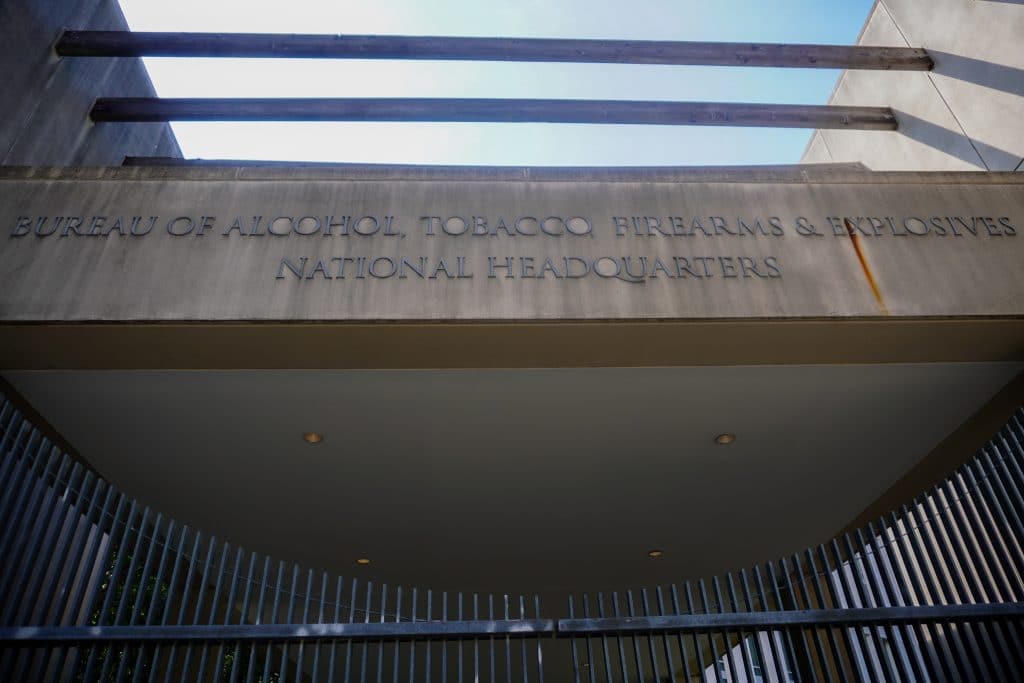We’re still waiting for the Senate parliamentarian to rule on whether removing silencers and short-barrel shotguns from the National Firearms Act (NFA) complies with the Byrd Rule.
Numerous sources tell me the Finance Committee’s section of the bill, which contains the NFA text, will start review today. But it’s unclear exactly when the NFA portion could be decided, with some sources saying it could be as late as Tuesday. And it’s anybody’s guess how, or even if, President Trump’s decision to bomb Iran last night will shake up the congressional schedule.
We’ve already written about why the reconciliation strategy is the best hope gun-rights activists have for getting parts of the NFA repealed. So, it’s important to explain what the risks of the plan are as well, which is what I do in my members’ piece this week.
But first, Contributing Writer Jake Fogleman does a deep dive into the Department of Justice’s (DOJ) proposed 2026 budget. That plan makes massive changes to how the federal government enforces gun laws, including huge cuts to the Bureau of Alcohol, Tobacco, Firearms, and Explosives (ATF) as well as a merger. It also provides new details on how the DOJ wants to implement its new gun-rights restoration process.
Plus, National Review’s Charles Cooke joins the podcast to explain why he thinks the federal gun free school zone is unconstitutional–but not because of the Second Amendment.

Analysis: Federal Gun Enforcement Would Drastically Change Under DOJ Budget Request [Member Exclusive]
By Jake Fogleman
The Trump Administration just released new budget documents that, if adopted, stand to dramatically shift how guns are regulated. There are a lot of hurdles to clear before the proposal can become law, though.
The Justice Department released its Fiscal Year 2026 budget request late last week. The sprawling 258-page document outlines how the department proposes complying with President Trump’s May discretionary budget request and its directive to slash non-defense discretionary spending and revamp federal agency priorities.
Here’s a look at some of the key details from the DOJ’s budget summary and what they might mean for gun owners.
Slashed ATF Budget
A reduction in funding for the Bureau of Alcohol, Tobacco, and Firearms (ATF) was already telegraphed by the President in his initial budget request last month.
“The Budget bolsters the Second Amendment by cutting funding for ATF offices that have criminalized law-abiding gun ownership through regulatory fiat,” the White House wrote in a summary document calling for a $468 million reduction in the agency’s budget.
The DOJ’s report appears to make good on that request and fleshes out how it will accomplish that goal. It calls for a 25.7 percent reduction in the agency’s budget compared to Fiscal Year 2025, resulting in a total budget of just over $1.2 billion. In doing so, it proposes eliminating 1,465 positions at the agency, the bulk of which will come from the inspectors currently tasked with oversight of the firearms industry. The reduction would impact roughly two-thirds of inspectors currently tasked with regulating federally licensed gun retailers and manufacturers.
“ATF will eliminate 541 Industry Operations Investigators (IOIs), reducing ATF’s capacity to regulate the firearms and explosives industries by approximately 40 percent in FY 2026,” the document reads. “ATF will perform fewer regulatory inspections of Federal firearms and explosives.”
Elsewhere, the department anticipates eliminating another 470 full-time agents and support personnel through standard attrition. It also plans to end current programs aimed at digitizing its crime gun tracing efforts as well as instituting a freeze on new vehicle purchases and personnel relocations to further reduce costs. The plan would also cut plans to further streamline ATF’s eForms processes, an effort that has already resulted in a massive decline in wait times for things like National Firearms Act registrations.
Proposed ATF Merger
Confirming a shift rumored to have been under discussion since at least March, the DOJ’s budget report also proposes terminating the ATF’s status as a standalone law enforcement agency, reducing its scope of work, and housing what remains under the auspices of the Drug Enforcement Administration.
“ATF is eliminated as a separate component, with its functions merged into the Drug Enforcement Administration (DEA),” the budget proposal reads. “After absorbing select functions of ATF, DEA will remain as a single component that will address violent crime, drug enforcement, and crimes relating to firearms.”
The justice department argued that pursuing the merger will lead to “efficiencies in resources, case deconfliction, regulatory efforts, and reductions of duplicative functions and infrastructure.”
Once consolidated, DOJ would take the departments with addressing both drug and gun crimes as they pursue “the fight to eradicate the designated cartel foreign terrorist organizations (FTOs) and seek to eliminate violent crime.”
Funding for Rights Restoration
Outside of proposed overhauls at the ATF, one area of the DOJ’s budget request that could impact gun policy actually comes in the form of a small funding hike.
The request calls for an additional $488,000 for the Office of the Pardon Attorney to “lead[] the Department’s initiative on creating and establishing a process for restoring firearm rights to citizens.”
While still relatively light on details, the request offers new insight into how the administration hopes to handle the recently revived firearm rights restoration process on more of an ongoing basis. Notably, the plan won’t fund even a single new position to oversee the process.
“This funding will allow PARDON to support development of an IT case management system to implement an application intake, review, and management process for citizens applying for the restoration of firearms rights,” the request reads. “The Department is committed to establishing a process to review and evaluate these claims at minimal cost. Working in conjunction with the Criminal Justice Information Services Team at the Federal Bureau of Investigation, the Office of the Pardon Attorney is developing an easy-to-use web portal for the acceptance of applications. The new process will leverage technological advancements and system integrations to maximize efficiencies and minimize the manual review of applications for restoration.”
Remaining Considerations
A significant caveat hangs over the administration’s budget proposal: while the President’s thoughts on federal spending certainly carry weight, they remain only that—a proposal.
Under Article I of the Constitution, Congress has the power of the purse. As such, the contours of what ultimately becomes the Fiscal Year 2026 budget will almost entirely depend on the political considerations of 535 lawmakers rather than one chief executive. As recent political history has demonstrated, appropriation bills that have made it into law have tended to differ significantly from the presidential budget proposals that preceded them.
Couple that with the politically fraught nature of something like merging the ATF and DEA, for instance, which has already drawn opposition not only from gun-control advocates and ATF leadership but also from gun-rights groups as well as the firearms industry itself, and it’s easy to imagine Congress leaving some of the administration’s more ambitious gun-policy-funding proposals on the cutting room floor.
At the same time, the President’s party currently controls both the House and the Senate. And, though their majorities are slim, thus far, Republican lawmakers have shown a tremendous amount of deference to the President, even when that has been politically challenging. Perhaps that pattern will hold during budget negotiations.
The funding for rights restoration, on the other hand, may ultimately prove to be less politically controversial and could easily become law regardless of the President’s sway over Congress. But it also stands to potentially be the least consequential. At just $488,000, with no actual staff dedicated to the project and a still-to-be-determined semi-automated application procedure, it’s unclear how effective this new rights restoration process will be. By comparison, the year before Congress defunded the original rights restoration process under ATF in 1991, the effort had a budget of over $4.2 million and employed 46 full-time staffers to process requests. That was 34 years ago.
While it’s certainly not out of the question that modern technology makes that kind of funding unnecessary in our current era, that still represents a 95 percent reduction in funding in real terms since the last time the federal government actively worked to restore the rights of previously disarmed Americans. Meanwhile, the number of possible applicants to such a process has grown to more than 25 million convicted felons, to say nothing of the millions of others who may fall under the other disqualifying criteria.
Of course, that concern, like much of the rest of the budget request, will have an opportunity to be addressed during the lawmaking process.
Podcast: NRO’s Charles Cooke on Challenge to Federal Gun Free School Zones [Member Early Access]
By Stephen Gutowski
This week, we’re taking a close look at the federal gun free school zones law with National Review’s Charles Cooke.
A federal appeals court just upheld the zones against a Second Amendment challenge for what may be the first time in the post-Bruen era. Cooke argued the law is bad policy, but he agreed it doesn’t violate the Second Amendment.
Instead, Cooke argued it’s actually an unconstitutional expansion of the federal government’s power to regulate interstate commerce. He noted the law had already been struck down by the Supreme Court over this issue once before. However, Congress passed a new version soon afterward. Cooke said the new law has the same problem the old one had.
We also talked about the current push to partially repeal the National Firearms Act through budget reconciliation. Cooke again said he’d like to see repeal make it through the process, but he had doubts that delisting silencers or short-barrel shotguns can clear the Byrd Rule. He also expressed some skepticism about whether language in the bill to try and nullify state NFA mirror laws would work in practice.
You can listen to the show on your favorite podcasting app or by clicking here. Video of the episode is available on our YouTube channel. An auto-generated transcript is here. Reload Members get access on Sunday, as always. Everyone else can listen on Monday.
Plus, Contributing Writer Jake Fogleman and I break down Senate Republicans’ new proposal to remove everything but machineguns and destructive devices from the National Firearms Act as part of President Trump’s “big beautiful bill.” We discuss the upsides and pitfalls of this approach for gun-rights advocates and explain what needs to happen next for it to become law. We also cover a new ruling out of the Fifth Circuit Court of Appeals on the federal Gun Free School Zones Act, a new DOJ brief arguing that AR-15s are protected by the Second Amendment, and emerging new details surrounding a tragic shooting at a recent protest in Salt Lake City.

Analysis: The Risks for Gun-Rights Advocates in Partial NFA Repeal Effort [Member Exclusive]
By Stephen Gutowski
The race to roll back the National Firearms Act of 1934 (NFA) took a leap forward this week, but the push isn’t without potential drawbacks for its supporters.
On Monday, the Senate Judiciary Committee released the text of its section of the budget bill. In it, Republicans granted the wishes of gun-rights activists and expanded on the House text. It incorporated short-barrel shotguns and rifles as well as “any other weapons” (think umbrella or cane guns) into the NFA delisting attempt.
We’ve covered why going after the NFA through budget reconciliation is likely the best shot advocates have at success anytime soon, but it’s important to understand the risks in the strategy, too. Both the short-term dangers of the language that made it into the Senate text and the long-term risks of the overall strategy.
While the Senate language is much closer to what the coalition of gun-rights groups ultimately wants in terms of how many categories of arms it delists from the NFA, it is also more vulnerable to an adverse ruling from the parliamentarian. Unlike the House language, which separates the tax elimination from the delisting provisions, the Senate language simplifies things by just delisting everything. The effect would be the same if they both made it into law, but the Senate’s approach raises the risk gun-rights advocates end up with nothing.
That’s because sources involved in drafting the bill widely believe delisting is the higher hurdle to clear during the Byrd Bath, where Democrats will challenge a number of provisions against the Byrd Rule. If the parliamentarian finds delisting doesn’t have a primarily budgetary impact, the tax elimination won’t be kept in. It all goes.
The American Suppressor Association’s (ASA) Knox Williams said there is a plan for that eventuality. If they lose on delisting, advocates are looking to get a Senator to offer up an amendment that just eliminates the taxes. That could certainly work, but there is some risk in trying to get a provision the parliamentarian stripped out added back in after the fact–especially with the breakneck pace Republicans are trying to achieve on this bill.
The same problem applies to the section of the text that attempts to address state-level NFA mirror laws. Some states require that anyone who wants to legally possess NFA items obtain federal permission first. If you cut some items from the NFA, it becomes impossible to get that permission and could therefore make it illegal for people in those states to own the delisted devices.
The Senate text tries to address this problem by basically declaring those state requirements moot. It’s unclear how states with mirror laws, like Colorado, or the courts would react to that language. But, also, more pressingly, the Senate left silencers out of that language. It only applies to short-barrel firearms and “any other weapons.”
That will need a fix before the bill gets to a final vote, which Williams said is also in the works.
ASA, Gun Owners of America, the National Rifle Association, and numerous other groups have been in lockstep during this push, though. And they’ve been successful in getting Republicans to do what they want. It’s a risk that doesn’t last, or that Republicans were only willing to put the full-fat delisting effort in the bill because they were confident it would get stripped out, but that’s a slimmer risk at this point.
The bigger risks come if the bill gets through in any form.
Primarily, the problem comes from precedent-setting. If Republicans can eliminate the NFA’s $200 tax on various items through reconciliation, Democrats can likely reinstate it and even raise it. In fact, that idea has already been suggested.
Pennsylvania Congresswoman Madeleine Dean (D.) said as much during markup of the House version.
“If we doubled it, if we just went to $400, you could sell only half as many and not lose a penny in revenue,” she said back in May. “If we tripled it, you might actually discourage some sales of silencers. Wouldn’t that be a good thing for us to be doing in this committee?”
Similarly, if Republicans can remove certain firearms and accessories from the NFA through reconciliation, Democrats can add them back later on. Perhaps they can even expand the reach of the NFA under the budget process’s 50-vote Senate threshold, too. Expanding the NFA to cover AR-15s and other firearms Democrats commonly call “assault weapons” has also been suggested before.
In fact, it was a prominent part of Joe Biden’s platform during his successful 2020 presidential campaign. He proposed a buyback of “assault weapons,” including the AR-15, that would “give individuals who now possess assault weapons or high-capacity magazines two options: sell the weapons to the government, or register them under the National Firearms Act.”
Biden didn’t get anywhere with that idea during his presidency, but it’s entirely possible the next Democrat or gun-control advocate to win the position when his party controls Congress could reanimate it. That possibility becomes much more likely if Republicans and gun-rights activists succeed in partially repealing the NFA through reconciliation. After all, gun-control activists have called on Democrats to outright nuke the filibuster to get to the same 50-vote threshold they could more easily reach through budget reconciliation instead.
So, those are the major risks for gun-rights activists in this effort.
Of course, many of the people leading this fight have already baked at least some of these risks into their calculus. It’s not hard to see why they’re almost certainly going to push forward anyway. Repealing parts of the NFA is nearly impossible any other way at this point. There aren’t 60 votes for this in the Senate. There may not even be majority support for this in the House as a standalone effort–if you could even get the floor time to get it to a vote.
Reconciliation in 2025 is the best chance for silencer and short-barrel shotgun delisting that activists are likely to see for at least another two years. Probably significantly longer than that if the current decline in the president’s polling numbers holds through the midterms. It’s now or never, and gun-rights activists will probably hold their concerns about how gun-control activists could use the same tactics to achieve the opposite results for after they see if they can actually get the most significant federal pro-gun reform across the finish line.
But they’re still real, and everyone should have their eyes wide open going into this.
That’s it for now.
I’ll talk to you all again soon.
Thank you,
Stephen Gutowski
Founder
The Reload







